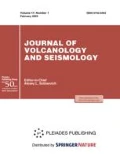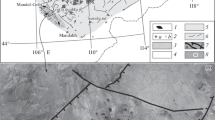Abstract
The Kekuknai massif was formed in the course of tectono-magmatic activity that involved the origin of a shield volcano and a caldera depression with associated emplacement of extrusions that terminated in intense post-caldera areal volcanism. The mineralogical compositions of the massif’s rocks have been considered in detail. The use of previously known and newly developed indicator properties of rock-forming minerals allowed the reconstruction of the general picture of the magmatic melt evolution and conditions of rock crystallization (various fluid and water saturation levels, as well as the oxidation state of the system). Essentially island-arc or intraplate characteristics of the massif’s rock compositions are found at different stages of development of a single fluid-magmatic system. Decompression evolution of the parent deep-seated basanitic magma occurred via occurrence in intermediate magma chambers of daughter magmas of trachybasalt (pre-caldera stage) or hawaiite (areal volcanism) composition. Subsequent emanate-magmatic differentiation of these melts, combined with crystallization differentiation under changing P-T-conditions, resulted in the formation of the entire diversity of the Kekuknai rocks.
Similar content being viewed by others
References
Bindeman, I.N. and Dubik, F.Yu., High-silica residual melt as a result of differentiation: Extrusive dacites of Mendeleev Volcano, Dokl. AN, 1990, vol. 312, no. 3, pp. 702–706.
Feeley, T.C. and Dungan, M.A., Compositional and dynamic controls on mafic-silicic magma interactions at continental arc volcanoes: Evidence from Cordon El Guadal, Tatara-San Pedro, J. Petrol., 1996, vol. 37, no. 6, pp. 1547–1577.
Grib, E.N., Pyroxenes in the effusive-explosive complex of the Uzon-Geiser-Valley depression, eastern Kamchatka, Vulkanol. Seismol., 1997, no. 4, pp. 14–35.
Koloskov, A.V., Anomalous magmatic zones at present-day island arc systems: The Koryak-Kamchatka volcanic zone, in Geodinamika, magmatizm i metallogeniya Vostoka Rossii (Geodynamics, Magmatism, and Metallogeny in Eastern Russia), Book 1, Khanchuk, A.I., Ed., Vladivostok: Dal’nauka, 2006, pp. 398–417.
Koloskov, A.V., Puzankov, M.Yu., and Pirozhkova, E.S., Ultramafic Inclusions in Island Arc Basaltoids: The Problem of the Composition and Genesis of the Transitional “Crust-Mantle Mixture” Layer in Island Arc Systems, in Geodi-namika i vulkanizm Kurilo-Kamchatskoi ostrovoduzhnoi sistemy (The Geodynamics and Volcanism of the Kuril-Kamchatka Island Arc System), Petropavlovsk-Kamchatskii: IVGiG DVO RAN, 2001, pp. 123–152.
Koloskov, A.V., Flerov, G.B., Perepelov, A.B., Melekestsev, I.V., Puzankov, M.Yu., and Filosofova, T.M., Evolution stages and petrology of the Kekuknai volcanic massif as reflecting the magmatism in backarc zone of Kuril-Kamchatka island arc system. Part 1. Geological position and geochemistry of volcanic rocks, J. Volcanol. Seismol., 2011, vol. 5, no. 5, pp. 312–334.
Martynov, Yu.A. and Chubarov, V.M., Pyroxenes as indicators for the genesis of the Eocene/Miocene contrasting volcanogenic formation in the lower Amur R. valley, Vulkanol. Seismol., 1982, no. 5, pp. 23–34.
Naumov, V.B., Kovalenko, V.I., Babanskii, A.D., et al., Genesis of andesites as revealed by studies of melt inclusions in minerals, Petrologiya, 1997, vol. 5, no. 6, pp. 654–665.
Panjasawatwong, Y., Danyushevsky, L.V., Crawford, A., et al., An experimental study of the effect of melt composition on plagioclase-melt equilibrium at 5 and 10 kbar: Implications for origin of magmatic high-An plagioclase, Contrib. Mineral. Petrol., 1995, vol. 118, pp. 420–432.
Perepelov, A.B., Puzankov, M.Yu., Ivanov, A.V., et al., Neogene Basanites of Western Kamchatka: Mineralogic and Geochemical Features and the Geodynamic Setting, Petrologiya, 2007, vol. 15, no. 5, pp. 524–546.
Petrograficheskii kodeks (Petrographic Code) Bogatikov, O.A. et al., Eds., St. Petersburg, 2009, pp. 24–25.
Ringwood, A.E., Composition and Petrology of the Earth’s Mantle, McGraw-Hill, 1975.
Speidel, D.H. and Nofriger, R.H., P-T-Fo2 relations in the system Fe-O-MgO-SiO2, Am. J. Sci., 1968, vol. 266, no. 5, pp. 205–238.
Sun, S.S. and McDonough, W.F., Chemical and isotopic systematics of oceanic basalts: Implications for mantle composition and processes, in Magmatism in the Ocean Basins, Geol. Soc. Lond. Spec. Publ. Vol., Saunders, A.D. and Norry, M.J, Eds., 1989, vol. 42, pp. 313–345.
Volynets, O.N., Geochemical types, petrology, and genesis of Late Cenozoic volcanic rocks from the Kurile-Kamchatka island-arc system, International Geology Review, 1994, vol. 36, pp. 373–405.
Volynets, O.N., Koloskov, A.V., Popolitov, E.I., et al., Geochemical features of olivines from different types of Quaternary basalts of Kamchatka and the Kuril Islands in connection with their petrogenesis, Geokhimiya, 1975, no. 3, pp. 412–419.
Volynets, O.N. and Koloskov, A.V., Plagioklazy chetvertichnykh effuzivov i maloglubinnykh intruzivov Kamchatki (Plagioclases in Quaternary Effusive Rocks and Shallow Intrusive Bodies in Kamchatka), Novosibirsk: Nauka, 1976.
Volynets, A. and Churikova, T., Woerner, G., et al., Mafic Late Miocene-Quaternary volcanic rocks in the Kamchatka back arc region: Implications for subduction geometry and slab history at the Pacific-Aleutian junction, Contrib. Mineral. Petrol., 2010, vol. 159, no. 5, pp. 659–687.
Whitaker, M.L., Nekvasil, H., Lindsley, D.H., et al., The Role of Pressure in Producing Compositional Diversity in Intraplate Basaltic Magmas, J. Petrol., 2006, vol. 48, no. 2, pp. 366–393.
Zinov’ev, V.I., Determination of plagioclase composition from chemical analyses of igneous rocks, Geol. Geofiz., 1964, no. 12, pp. 140–144.
Author information
Authors and Affiliations
Corresponding author
Additional information
Original Russian Text © A.V. Koloskov, G.B. Flerov, A.B. Perepelov, I.V. Melekestsev, M.Yu. Puzankov, T.M. Filosofova, 2013, published in Vulkanologiya i Seismologiya, 2013, No. 2, pp. 63–89.
Rights and permissions
About this article
Cite this article
Koloskov, A.V., Flerov, G.B., Perepelov, A.B. et al. The evolutionary stages and petrology of the kekuknai volcanic massif reflecting the magmatism in the backarc zone of the kuril-kamchatka island arc system. Part II. petrologic and mineralogical features, petrogenesis model. J. Volcanolog. Seismol. 7, 145–169 (2013). https://doi.org/10.1134/S0742046313020048
Received:
Published:
Issue Date:
DOI: https://doi.org/10.1134/S0742046313020048




